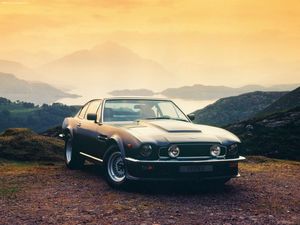.
Aston Martin V8: Difference between revisions
Red marquis (talk | contribs) m (→Photos) |
Red marquis (talk | contribs) mNo edit summary |
||
| Line 2: | Line 2: | ||
|Image = [[Image:Vantage.jpg|300px]] | |Image = [[Image:Vantage.jpg|300px]] | ||
|Marque = [[Aston Martin]] | |Marque = [[Aston Martin]] | ||
| | |aka = DBS <br>Oscar India | ||
|Production = 1973 - 1999 | |Production = 1973 - 1999 | ||
|Class = GT car | |Class = GT car | ||
Revision as of 07:19, 23 June 2008

| |
| Aston Martin V8 | |
|---|---|
| Aston Martin | |
| aka | DBS Oscar India |
| Production | 1973 - 1999 |
| Class | GT car |
| Body Style | 2-door coupe |
| Length | 4648 mm |
| Width | 1829 mm |
| Height | 1328 mm |
| Wheelbase | 2611 mm |
| Weight | 1724 kg |
| Transmission | 5-speed manual |
| Engine | V8 |
| Power | 340 bhp 5600 rpm
542 Nm 5600 rpm |
| Similar | {{{Similar}}} |
| Designer | {{{Designer}}} |
The Aston Martin V8 Vantage was hailed at its 1977 introduction as "Britain's First Supercar" for its 170 mph (274 km/h) top speed. Its engine was shared with the Lagonda, but the it used high-performance camshafts, increased compression ratio, larger inlet valves and bigger carburettors mounted on new manifolds for increased output. Straight-line performance was the best of the day, with acceleration from 0–60 mph (0–100 km/h) in 5.3 seconds, one-tenth of a second quicker than the Ferrari Daytona.
The Vantage name had previously been used on a number of high-performance versions of Aston Martin cars, but this was a separate model. Although based on the Aston Martin V8, numerous detail changes added up to a unique driving experience. One of the most noticeable features was the closed-off hood bulge rather than the open scoop found on the normal V8. The grille area was also closed off, with twin driving lights inserted and a spoiler added to the bootlid.
The Oscar India, introduced in 1978, featured an integrated tea-tray spoiler and smoother bonnet bulge. Inside, wood replaced some of the vinyl padding giving a more luxurious appearance. This line was produced, with some changes, until 1990.
The 1986-1989 580X V8 Vantage was more of a mechanical update. 16-inch (406-mm) wheels were now fitted, as was the more powerful V8 from the limited-edition V8 Zagato.
Cosmetic Vantages were built for the United States market — they lacked the powerful Vantage engine but retained the Vantage name, and the look was changed with a flattened hood. From 1980 they featured DOT-approved {{#ifeq:|on|}}{{convert/{{#if:1|mi/h}}|5|{{#ifeq:{{#expr:km/h*0}}|0|0}}|km/h|0|||r={{#ifeq:{{{sp}}}|us|er|re}}|d=LoffAonDbSoff|s=}} safety bumpers front and rear.
A Vantage Volante convertible version was also produced.
James Bond
James Bond's car (B549 WUU) in the 1987 film The Living Daylights is somewhat confusing. At the beginning of the film, the car is a V8 Vantage Volante (convertible), complete with Vantage badges. The car used in these scenes was a preproduction Vantage Volante owned by Aston Martin Lagonda chairman, Victor Gauntlett. Later, the car is fitted with a hardtop ("winterised") at Q Branch, and these scenes feature a pair of non-Vantage V8 saloons, fitted with the same number plate and Vantage badges as the initial car. Clearly, the later cars are intended to be the same Volante.[1]
The alterations and gadgets featured were:
- Tire Spikes
- Jet engine behind rear number plate
- Retractable outriggers
- Heat-seeking missiles behind fog lights
- Lasers in front wheel hubcaps
- Bulletproof windows
- Fireproof body
- Self-destruct system








